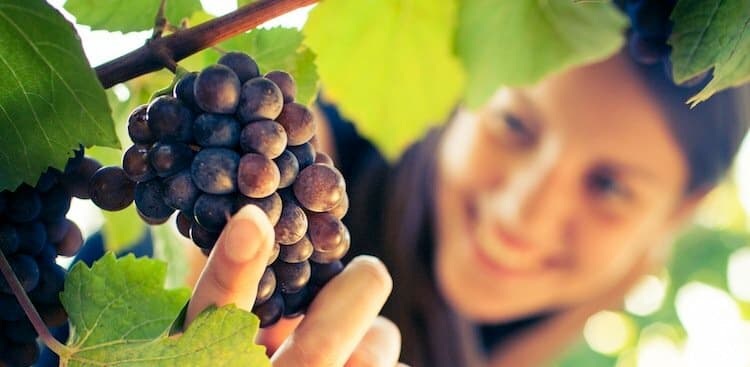Winemaking is one of those romantic-sounding careers that you dream about as you’re happily sipping on a big glass of Napa Cab after a long day at your desk job. But have you ever thought—just maybe—it could really be the path for you?
Helen Keplinger sure hadn’t for most of her life. Growing up in Ohio, she always loved wine, but working with it wasn’t an obvious career choice. But when she found herself questioning her chosen career in medicine, she turned back to her passion for wine and took a leap of faith.
Thank goodness she did. Helen has since had a varied and successful career, working at vineyards in California and Spain. She is currently focusing on her own label, Keplinger Wines, and was even named Winemaker of the Year by Food & Wine magazine last year.
We learned about Helen through one of her side projects, Wine for the World, a new organization that pairs successful U.S. winemakers with winemakers in developing countries to help mentor them and bring their wines back to the American market. We decided we wanted a little mentoring of our own—so we called Helen up to chat with her about her career and what it’s really like working with wine.
What made you decide to become a winemaker?
I grew up with wine always present in our family. My dad had a wine cellar—he wasn’t a trophy collector, he just bought wines he could drink every day. Every night at dinner my parents had wine on the table, so it was kind of this core experience growing up. Then, when I went to undergrad, I was still interested in wine and became the person who always picked out wine for dinner. Both friends and guys I dated would hand me the wine menu, which I loved.
At the time, I thought I would go into medicine, so I pursued science and then took a job doing medical research at Massachusetts General Hospital. I loved science, and I found it really fascinating, but the day-to-day of bench research wasn’t really a good fit for me. So, I decided to take a break from science and went to Thailand for a year to be a volunteer teacher.
When I came back, I was working on my medical school applications and working with the academic physicians with whom I had done research. When I asked them if they felt fulfilled, all of them said, “Gosh, yes, but if I could do it again I would…”—and none of them said medicine. It gave me good pause to think about what would be fulfilling on a day-to-day basis for me, so I went back to the drawing board and really re-thought my interests.
I loved being outside, nature, gardening, science, and I still loved wine. During this time I was reading Milady Vine, which is the autobiography of winegrower Philippe de Rothschild, and that made me think, “Is winemaking an option?”
I looked into it and saw that the University of California, Davis had a graduate program in winemaking, and I thought—this is it. It was such a cool blend of everything I loved that I took a huge leap of faith, abandoned my medical school applications, and moved out to California. And that was it.
Do you think people considering winemaking have to get that formal education, or are there other ways in?
I know a lot of people who haven’t done graduate school or a second baccalaureate, but they’ve apprenticed. That’s a great way to do it, especially if you can connect with a good mentor and you’re interested in learning. I get to hire people now, and I’m so happy to help good candidates get their start in the wine industry. As soon as you get a foot in the door there’s a good network of people, but that first step can be really hard, especially if you don’t live in a wine region.
What does your day-to-day actually look like?
It’s so seasonal, so it totally varies. As winemakers, we’re always working with three vintages. The first is the vintage that’s about to happen, 2013, which is what we’re setting up for now. The growing season for that has begun—so right now a typical week might involve meeting with one of my vineyard managers and walking through the vineyard to observe where things are: What do the plants look like? How even does it look? Do the vines look thirsty? Is the ground wet? Is the cover crop drying out?
Then, we’re dealing with last year’s vintage, 2012. That’s in barrel, and at this point in the year, it just finished its malolactic fermentation. The first six months of the wine’s evolution can be very dramatic, so I taste often to see what the wines are doing, whether they need something like a barrel change, if there’s something I notice that’s going to help me think about blends or what I’m doing with other vintages. We’re always collecting information like that.
And then the third vintage is 2011, which is at the point when it’s getting ready to be captured and bottled. We’re working on final blends—looking at all of the components, sampling the barrels and doing blending trials. And once that’s settled, we can order all of the glass, corks, capsules, and labels and set the bottling dates.
Those are all of the things that are happening. So, today I was at the winery making notes and pulling samples of the 2011s so I can go over the blending trials and see if I can improve them at all. Then I looked at the 2012s and had some samples pulled so I can taste and see where the wines are. This afternoon I’m headed out to look at some vineyards to see how the bloom is progressing.
But if you talk to me in August or September, I wake up in the morning and it’s straight to the vineyards before the sun warms things up and affects the flavors. I go out, look at the vines and see where they are and then sample the fruit and consider when to pick. When the fruit comes in, I make decisions about what it looks like, what it tastes like, and think about what I want to do with the fermentation or tanks or barrels.
I think that’s what I like so much about it—no two days are the same. We’re always governed by Mother Nature, and we can only respond and make the best decisions we can for that vintage and wine. You can’t do anything by recipe, you have to really think about it. It’s endlessly interesting.
What’s coming up in your career?
My own brand has been growing very slowly and organically, and this year I’ve been approached by a couple of growers who I really love and respect about working together. So we’ll have some really fun and super high-quality new vineyards to work with, which will be great for Keplinger. I’ve also always wanted to do a Cabernet label—probably not under the Keplinger label, since that’s focused on Rhone varietals. We’re also looking at starting another label that would be more accessibly priced—kind of an entry-level Rhone wine.
I also have great opportunities that aren’t paying me, which include working with Wine for the World, along with a couple other projects that don’t have a paycheck but that are interesting. It’s nice to be at a point where I can make decisions and do things because I’m really interested in being a part of something I find important or meaningful or exciting.
Do you have any advice for someone who thinks he or she might want to work with wine?
Try it, absolutely try it. An internship usually only lasts Labor Day through Thanksgiving or Christmas so it’s not a huge time commitment, and it’s a really great way to get a taste of wine country and winemaking. You can also use it to travel—one of the grads I’ve helped did two vintages, one here and one in Argentina.
You don’t have to end up doing it for the rest of your life, but try it if you think you’re interested. And it might lead to something else—maybe you decide you’d rather cook or do viticulture or write or do marketing or be a sommelier. There are so many different things you can do with an interest in wine, you just have to figure out where it fits in your life.
Want to learn more about Helen's work? Check out Keplinger Wines, or read more about Wine for the World at wine4theworld.com. You can support the organization and gain access to its first limited release of high-quality, responsibly produced wines through the end of May (just a few days left!) by visiting Wine for the World's Indiegogo page.

